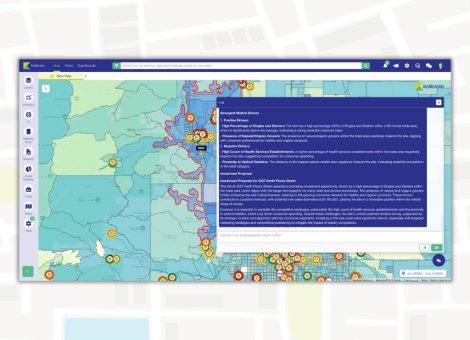Predictions for 2022: Top ten location intelligence predictions for 2022
As 2021 draws to a close and we look ahead to 2022, we’ve invited members of our team to shed some light on what we might expect next year for the retail, healthcare, and service industry sectors.
In our latest edition, Dave Huntoon from Intalytics, shares his predictions for the months ahead.
1. Predictable Covid-19 era performance in retail
For the first time in three years, retailers and restaurants will be able to predict with some assurance what their comparable sales growth will be. Since the beginning of the pandemic, and due to the associated closures, consumer behavior changed; making forecasting exceptionally challenging.
However, although there will be ongoing outbreaks and mutations from Covid-19, which will have an impact on consumer shopping habits and demand, these will now be anticipated by retailers and will be relatively predictable.
2. Steady eCommerce sales gains
Online shopping skyrocketed during the pandemic due to a combination of store and restaurant closures. As a result, online sales saw a significant spike, with the eCommerce market growing at an exponential rate; in the US, nonstore sales skyrocketed by more than 25% in Q3.
However, online purchasing as a proportion of total retail sales has now reached back to historical levels. Online retail sales jumped from 12.4% of total retail sales in Q3 2019 to 15.0% in Q3 2020, and have now settled back to a more historically consistent 14.0% in Q3 2021. Looking forward, as the market settles, retailers can expect a slow, but steady rise regarding online orders. Therefore, an omnichannel strategy will be key, with a mix of brick-and-mortar stores and an online presence being needed for retailers and restaurants.
To generate profits, these businesses must be guided by their customer demographic when deciding their offering, making sure they’re leveraging all the data available – the average customer spend and customer profiles (e.g. age, gender, etc) – which will enable the forecasting of behavioral patterns. From here, businesses can devise a steadfast omnichannel strategy that puts the customer first and does not solely rely on website algorithms – instead, this approach will consider location intelligence.
3. Telehealth is here to stay
Patients, providers, and insurers alike showed a willingness to embrace telehealth and remote appointments during the pandemic. While the majority of visits will continue to be in person given the nature of care provision in the medical and dental sectors, the increased use of virtual visits to triage basic healthcare needs will cause providers to re-evaluate their need for brick and mortar space as part of their location planning strategy. Expect the direct-to-consumer (D2C) trend to rise in 2022, with patients going straight to digital portals when requesting prescriptions and non-urgent care.
4. The “retailization” of healthcare will continue
Despite the growth of telehealth, healthcare providers will continue to seek out traditional retail locations, to better connect directly with patients (who are increasingly being viewed as consumers). Similarly, the distinction between healthcare, traditional ‘consumer-focused’ retail, and service offerings will continue to blur. This is nowhere more evident than in the primary care space, with drugstores and private equity-backed providers alike seeking to increase the market share.
5. Inflation – At last an excuse to raise prices
Retailers and restaurants have been constrained in their ability to raise prices for the past 10 years. However, with labor costs rising and issues with supply chains, it has resulted in higher price points for consumers. Expect price increases, or corresponding reduction in value, to persist throughout 2022; causing little clarity for businesses regarding long-term inflation trends.
6. Private equity rollups
The private equity world will continue to target selected industries with significant numbers of independent operators, looking to realize value through increased buying power, operational efficiencies, and best practices. Some of the industries that will experience the greatest impact include the veterinary, dental, and car wash sectors. Apparently, “Workin’ at the Car Wash, Yeah!”, which just celebrated its 45th birthday, is back in vogue.
7. The growth of the “Customer-Centric” perspective
The retail expansion has historically focused on the projected financial returns afforded by one-off store deployment decisions, or by investments in eCommerce and logistics. Successful operators have adopted a customer-centric approach – what combination of physical stores, eCommerce, shop-in-shops, channel partnerships, new prototypes will best serve existing and potential new customers? How to cater to audiences and provide the most profitable returns will all be an ongoing and ever-changing conversation in 2022.
8. Asset reprioritization
As an adjunct to the customer-centric theme, tenants across various industries will increasingly look to re-assess their existing brick and mortar deployments and close or relocate stores where appropriate. This is most significant for regional mall tenants, who need to reposition soon if they want to stay relevant.
Similarly, many food chains will begin to reconsider their locations, as a result of the increasing demand for fast food takeaways. For example, food chains will look at demand and analyze how close they are to their customers, limiting the reliance on third-party providers when completing deliveries. Removing this third-party dependency will improve their customer service, as direct employees of the food chains have an invested interest in the business. In other words, the closer they get to the customer, the better!
9. Retro Marketing: direct mail is back!
There had been a clear shift away from traditional marketing approaches such as direct mail in favor of digital outreach. However, in 2022 we will experience a mini-rebound in traditional marketing techniques as digital becomes more cluttered and more expensive, with many citing direct mail when it comes to better value.
10. Sears/Kmart
There will be fewer Sears and Kmart units open in the U.S. at the end of CY 2022 than at the beginning. (Our apologies – this has been a reliable prediction for many, many years; we just wanted to make sure we got at least one right!)
About Dave Huntoon, Managing Director, Intalytics

Dave has been actively involved in retail site selection and research since 1977. His professional career has focused on assisting retailers, restaurants, health care firms, banks, and services providers in developing expansion plans and generating sales forecasts for potential sites.
Read more articles about:
Location intelligenceSubscribe and get the latest updates
You may unsubscribe from our mailing list at any time. To understand how and why we process your data, please see our Privacy & Cookies Policy
Related posts
Location intelligence
Right-size your franchise territories: Maximize revenue per market
Franchise territory management tools are evolving changing with advances in location intelligence.

Location intelligence
AI in location intelligence: See it in action
See videos and screen captures of how AI has been integrated into the KLI platform.

